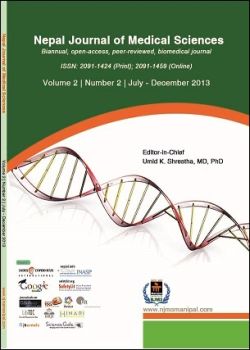Staphylococcus aureus: Prevalence among normal healthy individuals
DOI:
https://doi.org/10.3126/njms.v2i2.8968Keywords:
Staphylococcus aureus, CoNS-Coagulase negative StaphylococciAbstract
Background: To determine the prevalence of Staphylococcus aureus among normal healthy individuals in relation to age, gender and site of isolation.
Methods: A cross sectional study was conducted among healthy students and staff volunteers between the age group 15-65 years from Gulf Medical University (GMU) and Gulf Medical College Hospital and Research Centre (GMCH&RC), Ajman. Aseptically collected nasal and throat swabs were processed for direct Gram stain Microscopy and cultured on appropriate media. Based on the growth on Mannitol Salt Agar and tube coagulase test Staphylococcus aureus and Coagulase negative Staphylococci (CoNS) were grouped.
Results: Of the 127 voulnteers screened 67 were from GMU and 60 from GMCH&RC. From 49/127 (38.5%) volunteers 124 Staphylococci isolates were isolated. Of which 62 (50%) were Staphylococcus aureus and 62 (50%) were CoNS. Among the 62 Staphylococcus aureus 35 (56.45%) were from nasal swab and 27 (43.54%) were from throat swab. Of the 62 CoNS 44 (70.96%) were from nasal swab, 4 (6%) from throat swab and 14 (22.58%) were from both nasal and throat swabs.
Conclusion: The study revealed the asymptomatic inhabitation of Staphyloccus aureus in the nose and throat of healthy individuals. This should be seriously looked into since this in future may lead to carrier status. This alarms the hospital infection control committee to screen students and staff on regular basis to minimize the carrier status to protect the community.
Nepal Journal of Medical Sciences | Volume 02 | Number 02 | July-December 2013 | Page 160-164
Downloads
Downloads
Published
How to Cite
Issue
Section
License
Copyright © by Nepal Journal of Medical Sciences. The ideas and opinions expressed by authors of articles summarized, quoted, or published in full text in this Journal represents only opinions of authors and do not necessarily reflect the official policy of Nepal Journal of Medical Sciences or the institute with which the author(s) is (are) affiliated, unless so specified.




